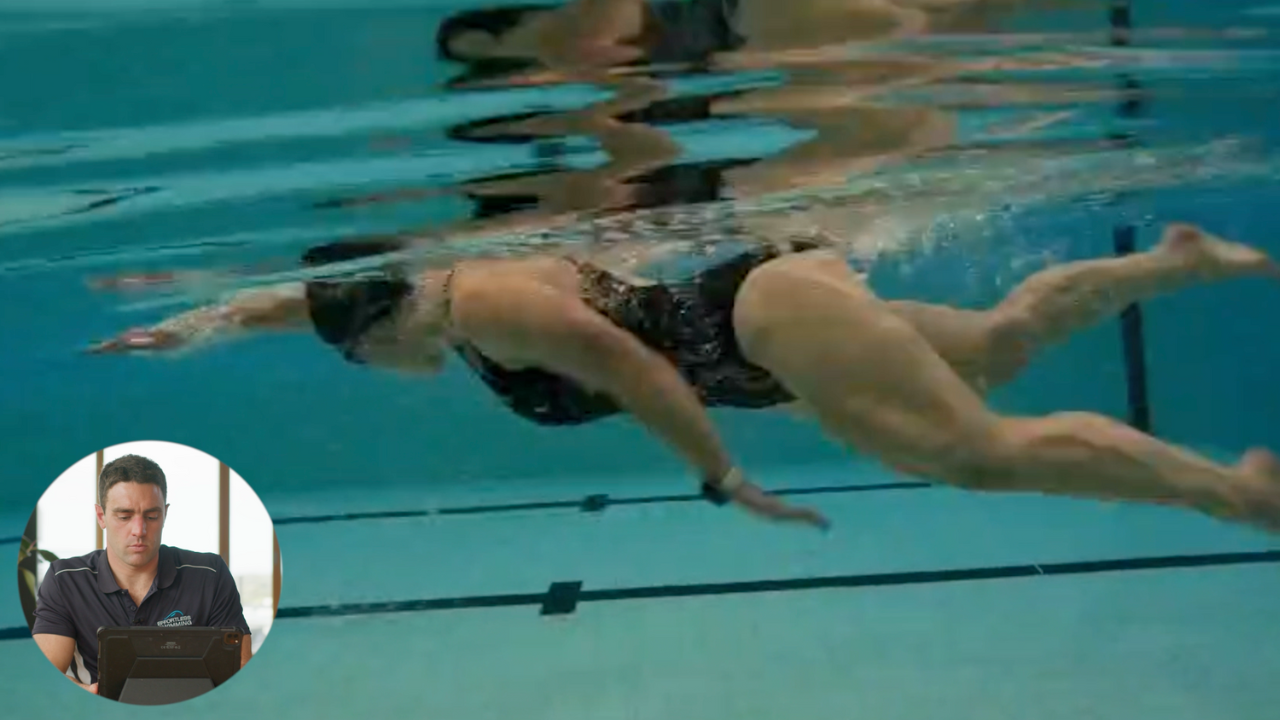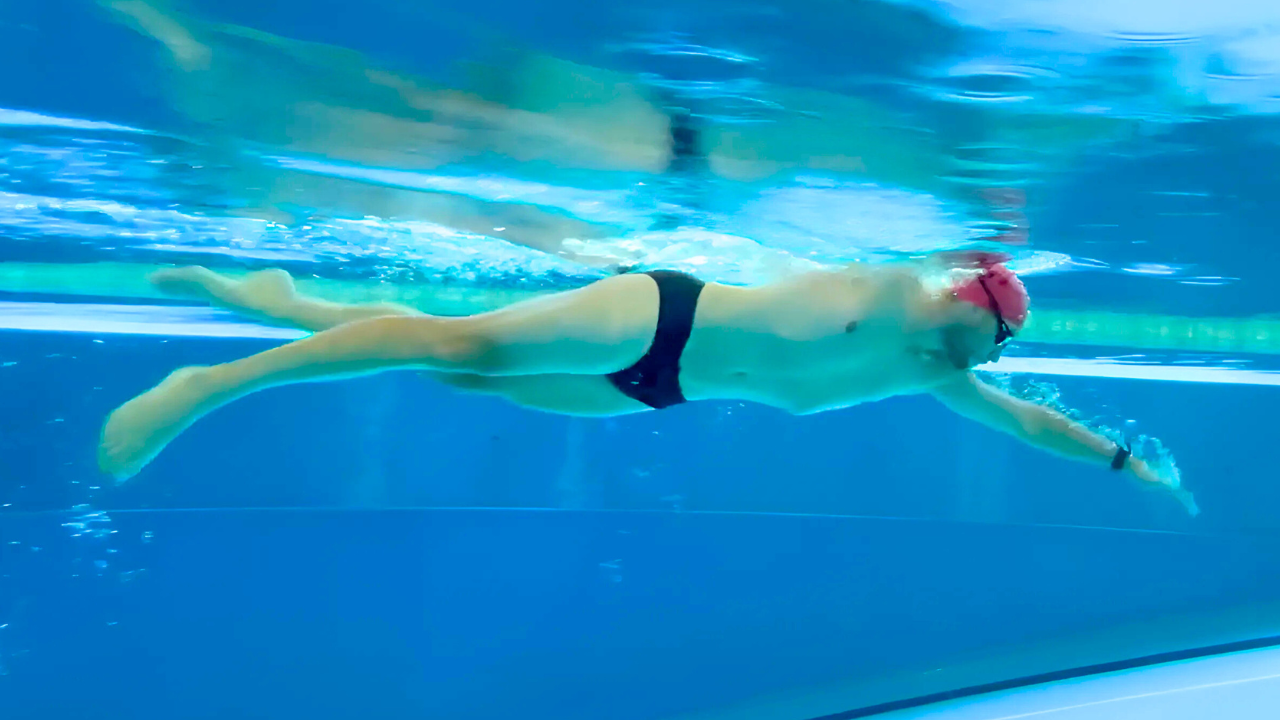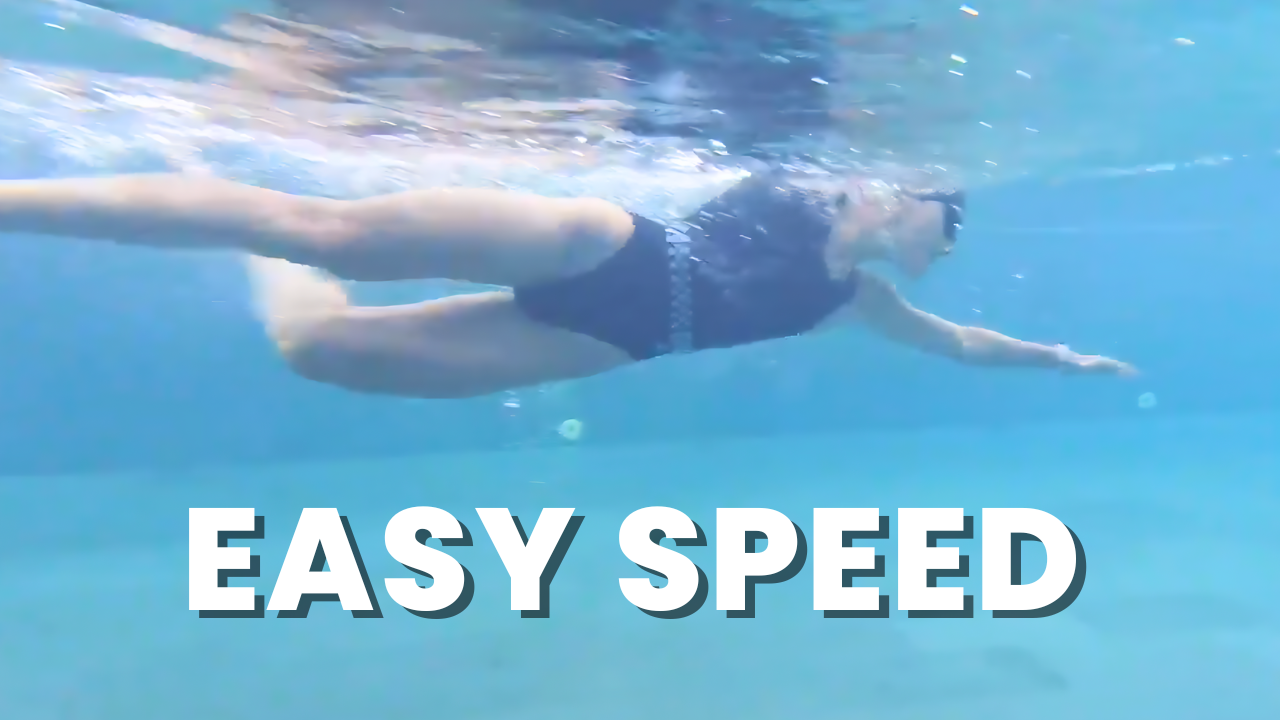This week in Feedback Friday, how can this swimmer reduce his stroke count by 2 to increase his speed by 6 secs/100m?
Transcription:
Hi. Brenton Ford here from Effortless Swimming. This is Feedback Friday. In today’s episode, we’re looking at a triathlete who sent his video in. He’s swimming around a 128 pace, holding 70 to 76 strokes per minute. Let’s take a look and see what we can find in terms of what we want to work on with his technique. How could this swimmer get down from a 128 pace per 100 down to the low 20s over the next couple of months?
Straight off the bat, you can see here that, in terms of his body position, he’s sitting a little bit low with his hips and with his legs. One of the biggest causes of that, as you can see, is just his head position. Where he looks, particularly after he looks forwards, a bit after he takes his breath, see where the eyes are. Straight out in front, and this causes this big arch in the lower back there.
We want to try and keep quite a straight body and that means a relatively straight spine. You’ll have a natural curve to it, but we do want to try and keep the spine somewhat straight, just with that … a more of a natural curve there. Whenever you look too far forwards and the eyes are looking straight out there, it’s always going to cause this. It’s really hard to keep the hips up on the surface and the heels up near the surface if you’re looking forwards. The first thing we’d look to do there is to adjust the head position. Now, as a triathlete, as an open water swimmer, you don’t need to look straight down. Anywhere from straight down to, I like to say 45 degrees in front, anywhere in that range is fine. We might start looking one or two meters out in front of him, as long as he keeps the back of his neck long and extended, and he tucks his chin back, that’s going to straighten out his spine somewhat.
That will allow him to have a much better connection through the core and it will take out some of this big arch in the lower back. That’s another thing that I would probably work on is just that posture and connection through here, because if we can just straighten him out a little bit as you can see in this video here, that’s going to allow him to sit a lot better in the water. Sit straight up, sit higher. That’s the first thing. Now another partial cause of that is probably going to be his entry. You can see on his left hand as he comes in here, notice how the elbow’s the first thing to enter. Then the hand enters and we’ve got this position right here where the hand is … well, the fingertip’s the highest point of the arm, and we want to always keep the fingertips as the lowest point of the … through this extension phase.
Some of that is going to be causing the legs to drop. What we’d look to do there, and what we’d need to do is just get the fingertips to enter first. Then you can have the hand extend and slide forwards, but always keeping those fingertips the lowest point. This is a much better position. This is great. You can see the fingertips are below the wrist, the wrist is below the elbow, a really nice position through here. That’s what we’d want to try and get to almost straight away. You can see as he moves through his catch on this left arm and he braces the right side on this left arm. It looks good from the beginning, but right here, see how those fingertips are still pointing forwards and he starts to press down a lot on the water? He’s missing out on this really important setup phase of the stroke, and that isn’t giving him much propulsion forwards.
One of the key things here would be to work towards a high elbow catch, or just a better catch position, basically just try and get those fingertips pointing down so the hand and the forearm can really be pressing back because here, again, we like to generally try and get the shoulder, the elbow and the hand all to line up underneath the shoulder there. Just because of this phase three here where those fingertips come forwards, he’s missing out on quite an important part of the stroke there. Now, obviously, it’s easier said than done. That’ll take some practice and some time. I’m going through some different drills and focusing on a few things there, but that is a big opportunity. He exits really nicely there. Just past the hip, finishes off really well. On this right side, you can see he enters fingers first, which is good.
A little bit too much of a bend through the wrist. We like to try and keep the hand in the forum connected as one paddle, particularly on the entry because if you’re entering like this, you’re going to be creating a bit of extra drag on top of that hand there. It does flatten out here, which is good, but that hand does ride just a little bit high and to me, there’s just a bit too much wrist bend through here. We’d like to try and have less of a bend through that wrist there. Hand and forearm should be a little bit straighter, but this is great. Really nice position through here. All right. Pressing back while fingertips are down. Much better catch position. You can see how much stronger that is. Much better all the way through, and that’s a really a good sign with the stroke.
You can sort of see how, if we go to a different angle here, I’m just going to cut to the front angle, you can see this position. Ideally, try and close the fingers up a little bit more. I normally wouldn’t see the thumb out that wide. Try and keep it in just a little bit closer, maybe closing the fingertips up a little bit more, but it’s not a huge thing. It’s just that really that bend through the wrist that we’d like to like to adjust, but it finishes really nicely. He comes in quite close to the center here through this back part and finishes off close to the hip. This is really good. You can see with his right arm if we look at this power phase position when he’s just passing the shoulder, this angle looks pretty good.
Now haven’t got the measurement tool on this app that I’m using here, but he’s … he’d be about 130 degrees through the arm. From the shoulder to the elbow, elbow to the hand, about 130 degrees. We’d like to try and get between 100 and 120 degrees. Ideally, that hand should just come in about there. That’s going to get him in a slightly stronger position, but not far from it. Now this left arm, you can see. See, this one goes quite deep and quite straight, so he’s probably not engaging his lats or the strongest shoulder and chest muscles through this part of the stroke because this left hand is down quite deep. This arm’s very straight and if you saw our last Feedback Friday we looked at the power diamond position or this half diamond position. That’s what we want to move towards, where he should be a little bit shallower.
The upper arm should be more in line with the shoulders in this phase of the stroke. Instead of having these triangles of one, two and three, we’d want to see one, two angles right there. You can see with the kick, timing is looking really good with the kick. He’s got quite flexible ankles, which is terrific and the heels are occasionally breaking the surface, which is good. You can see that overall posture with the legs, in terms of … it’s like he’s in that half-seated position. You can see that the legs and the thighs are always angled down from the hip. We’re not seeing much glute activation in the up kick. In this up right here, you can see this is the straightest point with his leg … or this is the highest point with his leg. The thighs are still sitting below that line of the hip.
Ideally, the glutes should be engaging a bit more to bring that leg up slightly straighter and not keeping the thigh below that line of the hips, because that’s always going to cause the legs to just trail behind you and create that extra drag. That’s what we look to adjust there too. There are some drills you can do to help engage the glutes. A good one is just lying on your stomach outside the pool and just working on bringing your legs up a bit straighter, making sure you’re driving it from the glutes and not the hamstrings and not bending straight from the knees. That’s a good way to to do it and that should help keep the legs a little bit closer together there too. Now the other one is the alignment. When we enter the water, we want the hand to enter it in line with the shoulder.
Have a look at this left hand here. Okay. See where that enters. Really quite wide of the shoulder and just in terms of a drag perspective, that’s going to be creating a lot of extra drag just through the inside of the arm here and through the shoulder. We always want to try and keep that hand and that arm directly in line with the shoulder to minimize drag. That’s going to set him up so much better through the stroke. Right-hand goes a little wide still. You can see he’s outside the line of the shoulder. Just a little bit too wide, but it’s mostly that left one. One thing we’d like to do is just get him to come in a little bit closer, more in line with the shoulders or the ears. That’s going to really minimize the drag there because if we’re looking at swimming in terms of how do we get faster, there are two ways that you can basically do it.
Well, sort of three ways actually. You can minimize drag. That’s better body position, keeping the legs a little bit tight, getting the alignment right. We can increase propulsion, so that’s a better catch and pull phase, more effective kick. We can also look at the stroke rate, or the cadence, on which you’re turning over with. His stroke rate and cadence are probably where he should be at in terms of his speed at the moment. Probably one of the main things that we’d look to do is just improve his distance per stroke by minimizing the drag and improving his propulsive phases of the stroke. You can also see here with the head position, so the breathing is just a little too far forwards. Probably looking a little far forwards here.
Ideally, looking straight to the side. That bottom goggle was in the water, which is good. You can see, I think mostly because of the head position … so we saw that he was looking a little bit too far forwards overall in a stroke. That can often lead to having the head and in this somewhat sort of awkward position where it’s up a little bit high. Try and keep that bottom goggle in the water looking straight to the side, half the head in, half the head out. Just because the eyes are forward from the beginning, it does put him in a … not so much a natural position for that breathing stroke.
There’s a couple of things that we’d work on. That would take quite a bit of time. For example, when someone comes along to a clinic, we’ll give them the tools and the drills to start the process of making these changes and we’d expect in the course of three to six months, they’d really be able to change their habits and improve their strike and be able to hold that in a race.
I wouldn’t expect that to happen within the course of two or three weeks. Looking at it at a more longterm approach is the best way to go. When someone joins the online coaching membership where they’ll send in videos and I’ll go through a full analysis and give them drills and specific things that they can do to work on their stroke, I’ll normally just simplify it. I wouldn’t give them all these things to work on. I’d normally pick one or two of the most important ones and then, in the course of a couple of weeks, once they do start that process of changing those first one or two things, then we might look at some other things to work on. It’s best to start simple. The most simple thing you could do here is just fix the head position. That would be the very first thing to work on.
Some simple math. Basically taking his stroke rate and stroke count, if we sort of look at that in a pretty simple way, at the moment he’s taking roughly 23 strokes per lap. His stroke rate, it varies between the different laps, but on a few of the laps, it’s around 76 strikes per minute. If he was able to get it down to 21 strikes per lap, so increasing his distance per stroke, but maintaining the exact same stroke rate, then you can see here the differences that that would make in his time. Now, this isn’t exact. It’s not figuring in the time for the turn and the time used for the streamline. You can see the overall improvement there just based on increasing his distance per stroke.
Now if you’ve watched our videos, you’ll know that that’s half the equation. We don’t just focus on distance per stroke. Stroke rate, cadence, that’s important as well, and particularly for open water swimming and triathletes, a really big focus. Not generally going to have the same distance per strokers in the late swimmer or someone who’s just doing swimming. Looking at getting the cadence up over time would be something else that we’d probably want to do. If he is holding low 70s and it depends on what races he’s doing, but let’s say he’s doing an Olympic distance triathlon 1.5 Ks, over the next 12 months he might look to get that stroke rate up to high 70s even low 80s if he can sustain that without spinning the wheels too much, because that’s probably where the guys in his age group are going to be.
Those right at the pointy end of the field, the top five percent in the swim, or even the top two or three percent in the swim, that’s probably where they’re going to be, somewhere in the high 70s to 80s to 90s. That’s where he looked to get to over the course of quite a few months and even years. You can see that difference there just in improving the distance per stroke. We want to work on both, but working on both does take time. Hope you enjoyed this video. Make sure to tune in next week for the next episode of Feedback Friday. If you would like to get some video analysis of your own stroke, we run clinics around Australia. You can see the link below. We also do online coaching where you can send in your videos and I’ll take a look at your stroke and work with you over the course of the next 12 months. Thanks for watching. See you next week.










